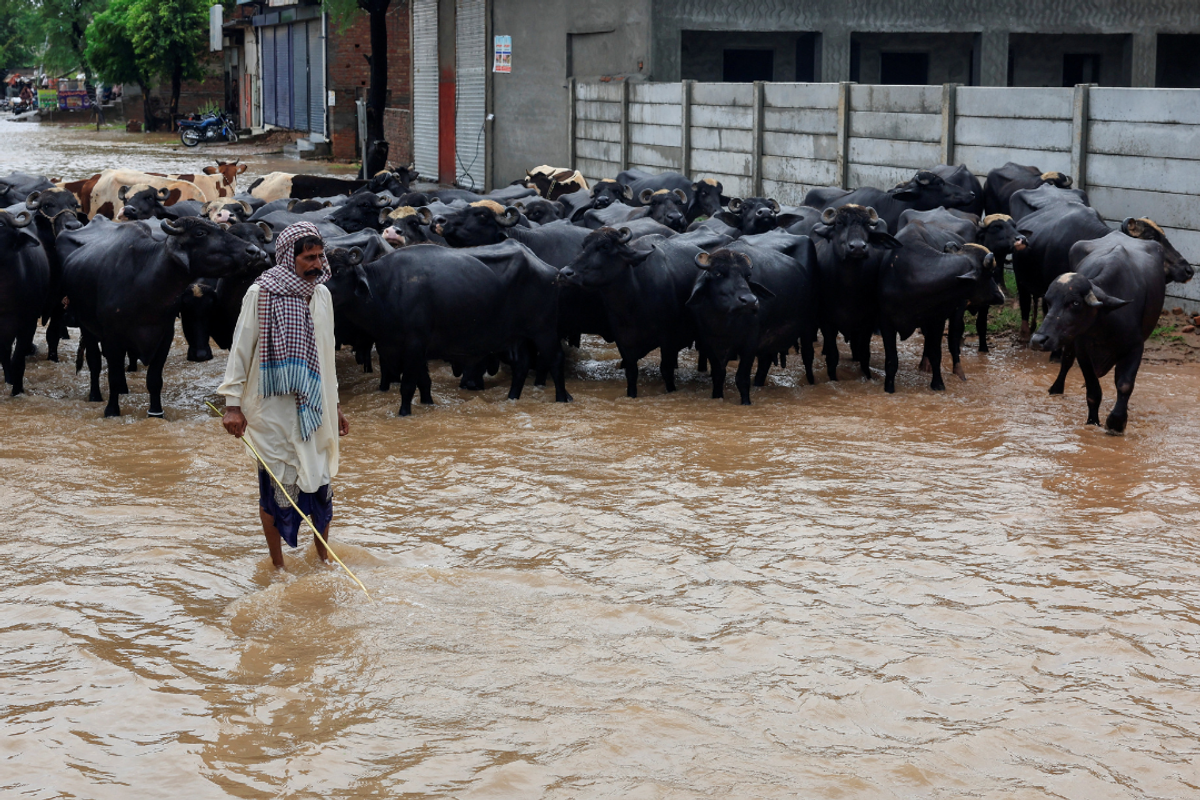Floods intensify inflation risks, threaten key crops in Pakistan
Analysts warn food shortages could push inflation to 8% as cotton, rice, and wheat face major losses
Business Desk
The Business Desk tracks economic trends, market movements, and business developments, offering analysis of both local and global financial news.

A man takes care of his herd of buffaloes along a flooded road, following monsoon rains and rising water levels of the Chenab River, in Sialkot district, Punjab province, Pakistan
Reuters
Floods have heightened inflationary risks in Pakistan by disrupting food supplies in rural areas and driving up wheat and flour prices, with inflation potentially hitting 8% in a worst-case scenario, according to a report by JS Global.
The brokerage said grocery items such as onions, tomatoes, and chilies are also expected to be in shortage. Tomato prices have already begun rising due to monsoon rains, and further increases are anticipated.
Any disruption from food shortages or supply bottlenecks could push inflation beyond JS Global’s base-case forecast of 6.5% for fiscal year 2025-26 (FY26). Weekly Sensitive Price Index (SPI) readings in September have remained elevated, with September inflation likely to come in at 5%.
Annual inflation projections now range widely, depending on assumptions: around 6.5% in the base case, 7.7% in a conservative scenario, 8.2% if elevated food prices persist, and up to 9.5% if trends from FY23 recur.
Flood impact on agriculture
Monsoon rains during June, July, and August exceeded seasonal norms, with recurrent cloudbursts, accelerated glacier melt, glacial lake outburst risks, and upstream water releases from India intensifying flooding across eastern Punjab. At least 23 districts have been affected.
While this year’s rains have evoked memories of the devastating 2022 floods, the Pakistan Meteorological Department reported at least 33% less rainfall compared to 2022. Still, the damage to crops, livestock, and textiles, which account for roughly 30% of the Consumer Price Index, remains a key risk.
JS Global estimates consumer price inflation could rise to 7.5-8% from its FY26 projection of 6.5% under elevated food inflation scenarios.
Cotton losses
Cotton, already in long-term decline, faces significant losses, with 20-30% of Punjab’s crop washed away. In Bahawalnagar district alone—the country’s second-largest producer contributing 12-15% of national output—losses are reported at 40%.
The government had targeted cotton output at 10.18 million bales, compared with 7 million achieved this year. Pakistan typically imports 3-4 million bales annually to meet demand of 12-13 million bales. With 4 million bales imported in FY25 at a cost of $1.2 billion, every additional 1 million bale loss could add $300 million to the import bill.
Rice at risk
Rice crops are also facing severe damage, with the Pakistan Business Council estimating 60% of Central and South Punjab’s rice crop destroyed. Pakistan earns about $3.5 billion annually from rice exports, but every 1 million ton loss could slash exports by $550-600 million.
Rice has expanded its cultivation area by 30% over the past two years, making the damage a significant setback for both exports and GDP growth.
Wheat delays
If floodwaters take months to recede, wheat sowing will likely be delayed, compounding an ongoing farmer shift toward edible oil crops.
Post-flood residue could further reduce yields. If 15% of wheat demand must be met through imports, the bill could reach $1.3 billion.
Livestock concerns
Floods have killed more than 6,500 livestock, far fewer than the 1.3 million lost in 2022, but still likely to create shortages in milk, meat, and poultry. Experts also warn of heightened disease risks among surviving livestock.







Comments
See what people are discussing